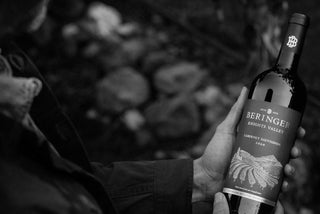Discover the artistry behind crafting Alluvium Blanc, a Bordeaux-style white wine that redefines Knights Valley's potential beyond reds.

Knights Valley: Located in Sonoma County
Beringer Vineyards has owned and farmed its Knights Valley vineyards since the mid-1960’s when the Beringer family recognized that the cobbled alluvial soils were a great place to grow high-quality wine grapes. The Knights Valley designation was first used on a Beringer label in 1974. Beringer was instrumental in garnering official recognition for the area in 1983 as a premier wine growing region in the form of its own American Viticulture Area (AVA) designation.
Located in a remote and bucolic location in Sonoma County just 17 miles north of the Beringer Napa winery, Knights Valley lies in the shadow of Mount St. Helena with hilly terrain that descends to rocky, alluvial soils where ancient rivers once ran. Not only has Knights Valley proved an exemplary producer of Cabernet Sauvignon and Sauvignon Blanc, but it also has an excellent combination of terrain, microclimates, and soils for a variety of experiments in viticulture that inform Beringer's finest wines and will continue to do so for vintages to come.

The Name: Alluvium Blanc
The name Alluvium Blanc reflects the vineyard's geological history. Knights Valley was formed through the action of rivers, which created alluvial fans as they swelled during winter and receded in summer. The name is a nod to the rocky soils that contribute to the unique character of the wine.
Picking the Grapes: A Collaborative Effort
Selecting the perfect grapes was essential to achieve the desired wine profile. The winemaking team was keen on finding grapes with emerging citrus notes, while others wanted to explore the vineyard's potential. In the end, they compromised and picked grapes based on their preferred profiles, later blending them to create the complex Alluvium Blanc.
The Creative Process: Stabulation and Experimentation
The winemaking team at Beringer had a specific goal in mind when crafting their Alluvium Blanc - they wanted an aromatic, fresh, and bright white wine that would really stand out. To achieve this, they used a cold and reductive style of winemaking known as 'stabulation,' which intensifies the wine's aromatics. After harvesting, the grapes are kept cold and pressed as whole clusters. The juice is then kept at a chilly 30-32 degrees Fahrenheit and mixed daily for up to three weeks before fermentation begins. Once finished, the wine is carefully racked off its lees to maintain its crisp and clean profile. The finished wine is then stored in stainless steel vessels until it's time to bottle. Although this method may seem unconventional, it's what gives Beringer's Alluvium Blanc that extra "pop" that sets it apart. The team divided the Alluvium block into two sections to capture both citrus and tropical nuances. Each section was fermented separately using the stabulation method, resulting in two distinct wines. One showcased tropical flavors, juicy mango, and pineapple, while the other exhibited lime cream, minerals, and saltiness. The final blend is a complex, layered wine that is crisp and precise, stored in a cold steel tank to preserve its character.
The Tasting Notes: Crisp and Fresh
With a pale straw color in the glass, the Alluvium Blanc’s aromas of key lime and gooseberry are immediately apparent, clean, and energetic. Awapuhi ginger flower blossoms, wet stone, and Himalayan salt notes leap out of the glass and help support lifted floral aromas of white flower blossom. On the palate, fresh acidity on the entrance helps to keep the fruit flavors focused and makes for a mouth-watering experience evolving into saline, juicy Asian pear and oyster shells.

Alluvium Blanc: A Versatile Food Wine
One of the main goals in crafting our Alluvium Blanc was to create a wine that pairs beautifully with food. Its versatility makes it a delightful choice for virtually any meal, especially during the summertime. With its crisp, salty, and layered profile, it's an ideal match for cheese and charcuterie, spring salads, oysters, or risotto.








